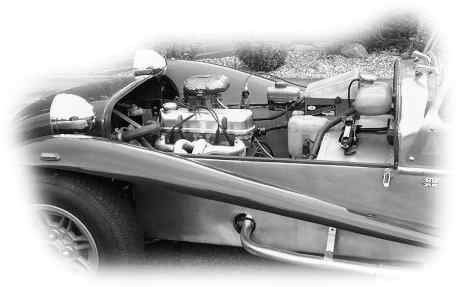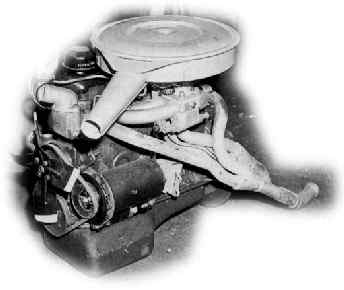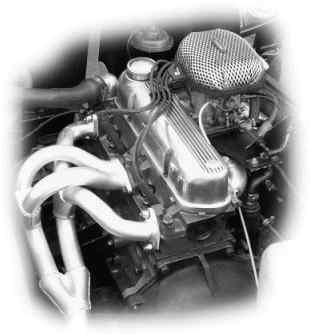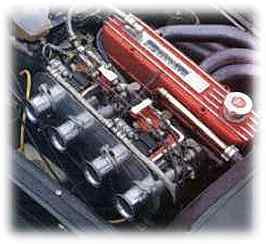| Search |
|
|||||||
|
Fords range of small engines produced through the 60s to 80s owe their basic design to the Anglia 105E engine that was first produced in 1959. The engine was unusual for the time, as it was over square, it had a large bore and a very short stroke. This meant that it could accommodate large valves in the head, which together with the small stroke made a very revable engine. The engine was picked up and turned into a competitive racing unit by numerous tuning firms including the new start up Cosworth.
Ford Pre-Crossflow Engine
There are basically two complete ranges of 1100, 1300, 1300GT, 1600
and 1600GT crossflow Ford engines. Those made between 1967 and Oct
1970 and the 711M block version introduced in late 1970. The early engines have varied head/ combustion chamber arrangements the 1098/1298 units have a completely flat head with a full combustion chamber in the piston crown whereas the 1300GT and all 1600cc units have a small combustion chamber in the head together with the main bowl in piston combustion chamber. The later 711M model cross flow units all use a completely flat head design and in fact have larger diameter inlet valves on all except the 1300GT version which, along with better porting, means the later type cylinder heads are most definitely superior to the earlier ones. If you are planning in increasing power output of a pre 1970 cross flow unit appreciably you are well advised to get hold of a later head. It's not good enough just to fit the larger inlet valves as the porting changes are important and, anyway, the valves are of a different length which will mean careful undercutting of the spring seats on earlier heads if they are to fit. As all the heads were now flat all engines had pistons with cut outs to clear the valves. The uprated engine has heftier main bearing caps, conrods and crankshaft despite the same part numbers being used. Camshafts were also uprated for the 711M engine the standard engines and 1600GT had the same cam design as the earlier version but the 1300GT had a new design. In 1975 when the MKII Escort was introduced the clutch size of the 1100 engine was increased to 7.5" to fall in line with all the other engines in the range. Various carburetors have been used over the years but all have been of a fairly poor standard with the exception of the Weber carbs fitted to the GT engines. The carb is a Ford produced version of the 28/36DCD that was used on the old 1500GT engine, although the Ford version has cast in chokes which can not be changed. The FWD versions of the engine have numerous differences including different engine mounting castings on the block that make it uneconomical to convert to RWD use as RWD blocks can still be obtained cheaply.
1300GT Crossflow installed in a Locust
When checking for wear and damage there are several items to watch out for. When cold the oil pressure at idle should be around 35-40psi. When hot this will drop to 15psi. At 3000rpm when hot the oil pressure should be around 35psi. If these figures can not be achieved with new oil and filter fitted either the oil pump is worn or the bearings are shot. The engine can also suffer from heavy breathing and oil being force from the filler cap due either to blocked breather system, worn valve guides, or bores but if this is happening it most likely will be a combination of both. The timing chain will stretch and eventually develop a rattle. This is easily fixed as the chain can be changed with the engine in the car. Rockers can wear giving loud tappet noises the shaft and rockers should be inspected and replaced if sign of wear is present. Camshafts also wear quickly and should be replaced whenever the engine is out of the car if it has done over 10000mls. Tuning the Crossflow for Road Use
The first step in tuning the 1100 is to change to the inlet manifold and dual-barrel carburetor fitted to the 1300 GT engine. This in conjunction with the 1300 GT exhaust manifold and system, will give an 8 to 12 bhp gain. The carburetor will have to be re-jetted to work well with this setup but given the cost involved this will be a worthwhile improvement. Unless there is any reason for keeping to this size of engine this is about as far as you should go without increasing the cubic capacity of the engine. The conversion to 1300cc is relatively easy as it only involves fitting new conrods and pistons from the 1300cc engine.
The same fist steps as per the 1100 engine should be applied to the 1300 engine. The fitting of the 1300 GT inlet manifold, carburetor and exhaust manifold is a good start which would form a solid base for further tuning measures you may want to carry out in the future. The next step after that would be to incorporate the 1300 GT camshaft and this, in conjunction with a big-valve cylinder head for optimum flow, will raise power output to somewhere around 80-82 bhp. The next step would be to raise the compression ratio by using 1100 pistons in the 1300 block. The resultant 10.7 to 1 compression ratio, in conjunction with a change of camshaft to something like a Piper 285 or Cosworth A2 profile would be very worthwhile. At this stage the fitting of the 1600 GT valves on both inlet and exhaust, together with uprated valve springs would give an extra gain in horsepower. It would also be worthwhile to remove the standard cooling fan and fit an electric thermostatic unit in its place. At this stage to make good use of the engine it will have to be able to be revved to at least 7000rpm so fitting steel rocker pillars and solid spacers between rockers will give the rigid valve train required. The power band will be between 2500 and 6500rpm peak torque will be at around 4800-5000 rpm. If the revs available are to be used it is advisable to balance the crank, rods and pistons and lighten the flywheel by 4-6lb.
Tuned crossflow with 40DCOE Carburetors The next step would be to fit twin 40DCOE Webers with quality filters from the likes of K&N or Piper Cross. Providing that the engine has been put together well you should have an engine that produces just over 100bhp. The engine can still be tuned further but it now starts getting more expensive for relatively small increases in bhp. The next step would be to fit a large bore 4 into 1 exhaust manifold and matching large bore exhaust system. Replace the distributor with a good quality electronic ignition system mapped to the engine requirements. The compression ration can be upped again by machining the cylinder block top face and machining valve cutouts in the pistons. The compression ratio should be about 11.2 to 1 you will have to be careful with the quality of petrol used and an octane booster may be necessary nowadays. You should use 41mm inlet and 35.7 exhaust valves from a reputable tuner such as Burton or Vulcan. This is about as far as you can sensibly go with the 1300 capacity and still run the engine in a road car. The 1300 cylinder block has thick enough walls to allow a overboring to take place. So provided that you are not limited to a 1300 capacity you should consider overboring the engine. In all cases the 711M block should be used as it is stronger. The combinations that are possible are numerous. They begin with the simple Ford oversize of 60-thousands giving a capacity of 1340cc. The next step would be to overbore for a piston diameter of 83.5 will give a capacity of 1380cc and would make the 285/A2 camshaft more usable it would increase the torque and smooth the engine idle. Using 85mm pistons would give a capacity of 1429cc but this would need careful inspection of the block as there is a slight danger of breaking through during the rebore. At this stage the engine should be producing around 125bhp.
All the above can be applied to the 1600 engine but the torque and horse power increases would be increased for example the 1600 can easily be brought up to 1600GT specification by fitting the carburetor, exhaust system and camshaft. This would bring the bhp up to around the 86bhp of the GT engine. Like the 1300 the compression ratio of the 1600 can be upped by using the next smaller engines pistons 1300cc pistons in a 1600cc block will give a compression ratio of about 11 to 1. The engines can also be overbored as per the 1300cc versions. 83.5mm pistons give a capacity of 1700cc, which will bring a GT spec, engine's output up to about 115bhp. If a 285 or A2 profile camshaft is used with a suitably jetted GT carburetor 122 to 126 bhp can easily be achieved. Maximum safe revs would be 6800rpm and the engine would benefit from balancing and lightening the bottom end. 85mm pistons would give a capacity of 1760cc but as with the 1300 breakthrough can occur but the 711M block is usually safe at this size. At this stage of tune as always the increases in bhp become more expensive. Larger valves 1.625 inlets chambered heads more radical camshaft profiles and twin 45DCOE Weber carburetors are the next steps which will bring the bhp up to about 135-145 on the 1700-1760cc engines. Any further tuning would require that the engine rev beyond the safe limit of 6800rpm of the standard Ford 1600 crankshaft. An all steel bottom end would be necessary but it would be too costly for non competition use. An easier option would be to fit a different engine such as a modern Ford Zetec or Cosworth unit.
Ford Zetec Engine |
|||||||
 |
|
|






